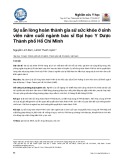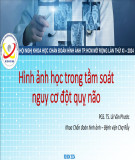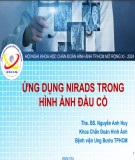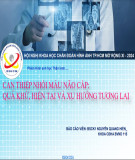Available online http://ccforum.com/content/7/3/245
Letter Intramucosal–arterial PCO2 gap does reflect tissue dysoxia — authors’ response Arnaldo Dubin1 and Elisa Estenssoro2
1Principal Investigator, Cátedra de Farmacología, Facultad de Ciencias Médicas, Universidad Nacional de La Plata, La Plata, Argentina 2Medical Director, Servicio de Terapia Intensiva, Hospital Interzonal General de Agudos “Gral. San Martín” de La Plata, La Plata, Argentina
Correpsondence: Arnaldo Dubin, adee@infovia.com.ar
Critical Care 2003, 7:245 (DOI 10.1186/cc2180)
Published online: 31 March 2003 This article is online at http://ccforum.com/content/7/3/245 © 2003 BioMed Central Ltd (Print ISSN 1364-8535; Online ISSN 1466-609X)
necessarily mean that there is a greater oxygen debt in IH. This finding has previously been reported by other researchers [4]. It could indicate an alteration in oxygen extraction capacity in HH. It could also explain the finding that VO2 decrease and metabolic acidosis were similar in the groups, even though oxygen transport was somewhat higher in the HH group.
The main criticism of Gutierrez and Turkan [1] to our recent paper [2] is the absence of anaerobic metabolism in the hypoxic hypoxia (HH) group as an explanation for lack of increase in intramucosal–arterial PCO2 gradient (∆PCO2 ). Despite their elegant arguments, we still believe that the animals in the IH group were in an anaerobic state. Our statement is supported by the following.
Respiratory quotient We have some concerns about calculation of respiratory quotient (RQ) relating to multiple propagation of errors. In addition, how RQ behaves in HH is not yet adequately defined. Vallet and coworkers [4] have showed a trend toward decreased RQ during the last step of progressive hypoxaemia, which they attributed to the Haldane effect.
The presence of oxygen supply dependence Although the reduction in oxygen transport was greater in ischaemic hypoxia (IH), there were comparable falls in systemic and intestinal oxygen consumption in HH. We agree with Gutierrez and Turkan that oxygen supply dependence is not an infallible marker of anaerobic metabolism. However, the occurrence of compensatory mechanisms to lower tissue metabolic rate and to decrease oxygen consumption (VO2) in response to hypoxaemia in an acute setting seems unlikely. Consequently, we consider the fall in VO2, as well as the metabolic response, to represent evidence of anaerobic metabolism [3].
Conclusion For these reasons, we conclude that our HH group was indeed in an anaerobic state, and that this was evidenced by the fall in VO2. In spite of this, we agree with Gutierrez and Turkan [1] that further experimental studies on this subject are needed. In this way, recent work from our laboratory on anaemic hypoxia has reinforced the conclusion that intramucosal–arterial PCO2 gradient (∆PCO2) is primarily determined by blood flow, irrespective of the presence of tissue hypoxia [5].
We greatly appreciate the thorough criticisms of Drs Gutierrez and Turkan, and the opportunity to answer them.
References 1. Gutierrez G, Turkan H: Intramucosal–arterial PCO2 gap does reflect tissue dysoxia [letter]. Crit Care 2003, 7:243-244. 2. Dubin A, Murias G, Estenssoro E, Canales H, Badie J, Pozo M, Sottile JP, Barán M, Pálizas F, Laporte M: Intramucosal–arterial PCO2 gap fails to reflect intestinal dysoxia in hypoxic hypoxia. Crit Care 2002, 6:514-520
Metabolic acidosis As was pointed out by Gutierrez and Turkan [1], another parameter that may be used to determine the onset of anaerobiosis is the presence of increased H+ concentration in tissues and blood. Nevertheless, we do not agree with their explanation of the lack of change in bicarbonate in HH. We believe that, in HH, bicarbonate remains unchanged because of concomitant increase in arterial PCO2 and subsequent buffer titration. Additionally, base excess, a better indicator of metabolic state, had a similar reduction of approximately 10 mmol/l (data not shown in the study) in both groups. Thus, the magnitude of metabolic acidosis, as a marker of tissue hypoxia, was comparable in the groups.
3. Cain SM: Oxygen delivery and uptake in dogs during anemic
4.
and hypoxic hypoxia. J Appl Physiol 1977, 42:228-234. Vallet B, Teboul JL, Cain S, Curtis S: Venoarterial CO2 differ- ence during regional ischemic or hypoxic hypoxia. J Appl Physiol 2000, 89:1317-1321.
5. Dubin A, Estenssoro E, Canales H, Piacentini E, Pozo M, Sottile JP, Barán M, Murias G, Pálizas F, Etcheverry G: Intramucosal- arterial PCO2 gap fails to reflect intestinal dysoxia in anemic hypoxia. Intensive Care Med 2002, 28:S127.
Oxygen extraction ratio Despite the fact that systemic and intestinal oxygen extraction ratios were lower in the HH group (64% and 56%, respectively) than in the IH group (87% and 78%, respectively) in the last step of decreasing oxygen transport, this does not
245 HH = hypoxic hypoxia; IH = ischaemic hypoxia; PCO2 = partial carbon dioxide tension; RQ = respiratory quotient; VO2 = oxygen consumption.




































